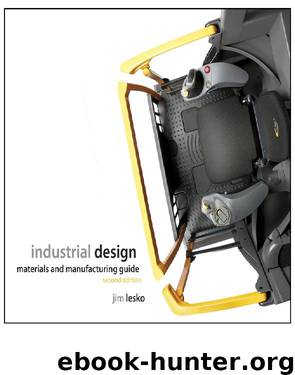Industrial Design by Lesko Jim

Author:Lesko, Jim
Language: eng
Format: epub
Publisher: John Wiley & Sons
Published: 2011-09-22T16:00:00+00:00
8.1 Properties of Molded Plastics
figure 8-7. selected properties and behaviors chart
Molded plastics offer a wide range of physical and mechanical properties, as well as some unusual mechanical behaviors. Changes in the polymer repeat units, chain length, crystallinity, or level of cross-linking can yield materials with properties ranging from strong to weak, brittle to tough, or stiff to elastic. Under certain conditions such as elevated temperatures and/or long-term loading, resins behave quite differently from other engineering materials. The following is a brief summary of selected properties.
Viscoelastic Behaviors
Viscoelasticity
Plastics have a dual nature, displaying characteristics of both a viscous liquid and a spring-like elastomer, or traits known as viscoelasticity. This duality accounts for many of the peculiar mechanical properties found in plastics. Under mild loading conditions such as short-term loading with low deflections and small loads at room temperatures plastics usually respond like a spring, returning to their original shape after the load is removed. No energy is lost or dissipated during this purely elastic behavior: Stress versus strain remains a linear function. Increasing the applied load adds a proportional increase to the part’s deflection.
Many resins exhibit a viscous behavior under long-term heavy loads or elevated temperatures. While still solid, resins will deform and flow similarly to a very high-viscosity liquid. To understand this viscous behavior, it is important to understand strain and stress. Strain is measured in percent elongation; stress is measured in load per area. Typical viscous behavior for tensile loading shows that strain resulting from a constant applied stress increases with time. This time-and-temperature-dependent behavior occurs because the polymer chains in the part slip and do not return to their original position when the load is removed.
The Voigt-Maxwell model of springs and dashpots illustrates these viscoelastic characteristics. The spring in the Maxwell model represents the instantaneous response to loading and linear recovery when the load is removed. The dashpot connected to the spring simulates the permanent deformation that occurs over time. The Voigt model shows the slow deformation recovery after the load is removed. While it is not a practical model for structural design use, the Voigt-Maxwell model offers a unique way to visualize viscoelastic characteristics.
Creep
One of the most important consequences of plastics’ visco-elastic behavior, creep, is the deformation that occurs over time when a material is subjected to constant stress at a constant temperature. Under these conditions, the polymer chains slowly slip past one another. Because some of this slippage is permanent, only a portion of the creep deformation can be recovered when the load is removed. The tensile test in figure 8-9 clearly demonstrates creep. A weight hung from a plastic tensile bar will cause initial deformation d increasing the bar’s length. Over an extended period of time, the weight causes more elongation, or creep c.
Stress Relaxation
Another viscoelastic phenomenon, stress relaxation, is defined as a gradual decrease in stress at a constant strain and temperature. Because of the same polymer-chain slippage found in creep, stress relaxation occurs in simple tension, as well as in parts subjected to multiaxial tension, bending, shear, and compression.
Download
This site does not store any files on its server. We only index and link to content provided by other sites. Please contact the content providers to delete copyright contents if any and email us, we'll remove relevant links or contents immediately.
| American National Standards Institute (ANSI) Publications | Architecture |
| History | Measurements |
| Patents & Inventions | Research |
Whiskies Galore by Ian Buxton(41935)
Introduction to Aircraft Design (Cambridge Aerospace Series) by John P. Fielding(33085)
Small Unmanned Fixed-wing Aircraft Design by Andrew J. Keane Andras Sobester James P. Scanlan & András Sóbester & James P. Scanlan(32763)
Craft Beer for the Homebrewer by Michael Agnew(18194)
Turbulence by E. J. Noyes(7977)
The Complete Stick Figure Physics Tutorials by Allen Sarah(7334)
Kaplan MCAT General Chemistry Review by Kaplan(6897)
The Thirst by Nesbo Jo(6877)
Bad Blood by John Carreyrou(6581)
Modelling of Convective Heat and Mass Transfer in Rotating Flows by Igor V. Shevchuk(6406)
Learning SQL by Alan Beaulieu(6235)
Weapons of Math Destruction by Cathy O'Neil(6206)
Man-made Catastrophes and Risk Information Concealment by Dmitry Chernov & Didier Sornette(5951)
Digital Minimalism by Cal Newport;(5699)
Life 3.0: Being Human in the Age of Artificial Intelligence by Tegmark Max(5506)
iGen by Jean M. Twenge(5384)
Secrets of Antigravity Propulsion: Tesla, UFOs, and Classified Aerospace Technology by Ph.D. Paul A. Laviolette(5330)
Design of Trajectory Optimization Approach for Space Maneuver Vehicle Skip Entry Problems by Runqi Chai & Al Savvaris & Antonios Tsourdos & Senchun Chai(5036)
Pale Blue Dot by Carl Sagan(4949)
